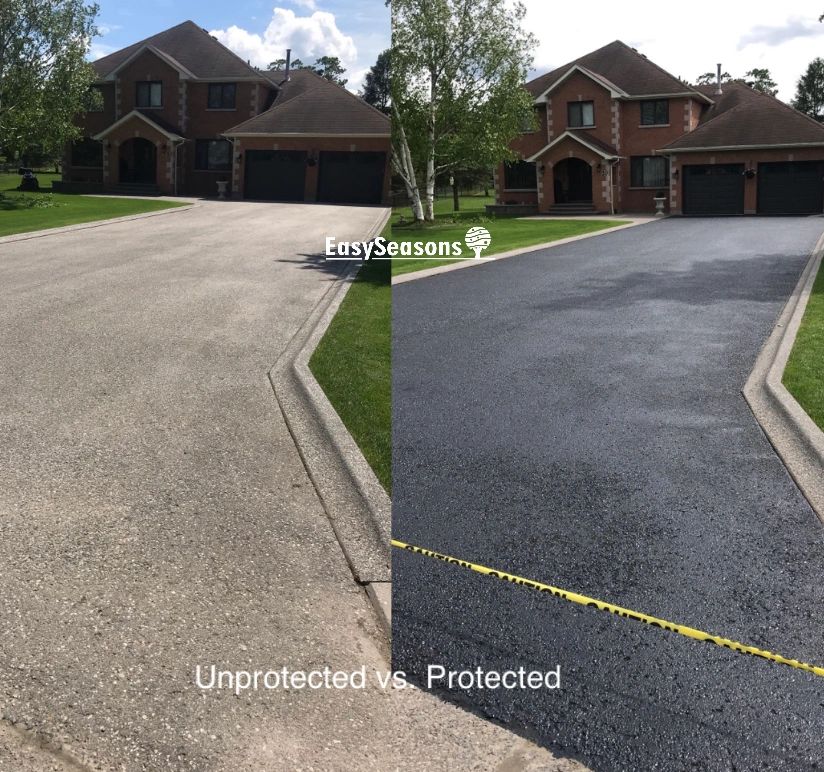Elevate Security and Charm: Angled Parking Lot Solutions with Asphalt Sealing
Elevate Security and Charm: Angled Parking Lot Solutions with Asphalt Sealing
Blog Article
Warm Mix Asphalt: A Lasting Option for Sidewalk
Hot Mix Asphalt (HMA) has actually emerged as a leading lasting option for sidewalk options, providing a myriad of ingenious modern technologies and ecological benefits. As the need for environmentally friendly building and construction methods grows, exploring the subtleties of HMA's sustainability can offer valuable understandings into the future of sidewalk solutions.
Ecological Advantages of Hot Mix Asphalt

In Addition, Hot Mix Asphalt aids to reduce city warm island results. Its dark color soaks up sunlight, lowering the amount of warmth reflected back right into the environment compared to lighter-colored pavements. This can decrease ambient temperatures in urban locations, decreasing the need for cooling and eventually lowering energy usage.
Additionally, Hot Mix Asphalt adds to improved stormwater administration. Its porous nature allows water to infiltrate the pavement and reenergize groundwater products, reducing runoff and the danger of flooding. These environmental advantages make Warm Mix Asphalt a lasting selection for paving roads and freeways.
Power Performance in HMA Manufacturing
Is energy effectiveness an important aspect in the production of Hot Mix Asphalt (HMA)? Energy plays a significant function in the production of HMA, influencing both expense and ecological sustainability. One vital element of energy performance in HMA production is the use of warm mix asphalt (WMA) technologies.
Moreover, innovations in plant innovations have actually led to even more energy-efficient HMA production procedures. By enhancing power usage in HMA production, the market can decrease its carbon footprint while keeping top notch sidewalk materials.
Recyclability of Hot Mix Asphalt
The recyclability of Warm Mix Asphalt (HMA) is a pivotal element of its sustainability and long-lasting ecological impact. HMA is among one of the most recycled products in the USA, with over 100 million lots of redeemed asphalt sidewalk (RAP) being reused annually in new pavement building. Reusing HMA supplies numerous environmental benefits, such as lowering the need for virgin materials, reducing energy usage during manufacturing, and lowering the amount of waste sent to garbage dumps.
The procedure of recycling HMA involves milling the existing sidewalk, squashing it into smaller pieces, and blending it with brand-new aggregate and asphalt binder to develop a recycled mix. On the whole, the recyclability of HMA plays a significant function in promoting lasting methods within the pavement market.
:max_bytes(150000):strip_icc()/barricade-tape-sealed-driveway-big-56a583145f9b58b7d0dd3d87.jpg)
Long-Term Efficiency of HMA
Asphalt sidewalks demonstrate longevity and strength over an extensive duration, reflecting the lasting performance of Hot Mix Asphalt (HMA) Additionally, innovations in HMA innovation, such as the usage of polymer-modified binders and warm mix asphalt, have better improved the longevity and durability of HMA sidewalks. By focusing on quality building and construction and maintenance methods, HMA proceeds to confirm itself as a affordable and lasting solution for resilient sidewalk infrastructure.

HMA: Durability and Sustainability
Showing both sturdiness and sustainability, Hot Mix Asphalt (HMA) has actually ended up being a cornerstone in the building and construction of lasting sidewalk facilities - hot mix asphalt. HMA's toughness stems from its capacity to withstand hefty loads, extreme weather, and high website traffic volumes, making it a trusted option for highways, highways, and airport terminal paths. look at this website The composition of HMA, which commonly includes accumulations, binder, and filler, plays an essential function in boosting its longevity and resistance to damage
Furthermore, HMA's sustainability exists in its recyclability and energy-efficient manufacturing process. The capability to recycle redeemed asphalt pavement (RAP) in brand-new HMA blends reduces the demand for virgin materials and decreases the environmental effect of sidewalk construction and maintenance. Furthermore, the power performance of producing HMA lies in its lower mixing temperature levels contrasted to various other sidewalk materials, causing reduced power intake and greenhouse gas emissions.
Conclusion
Finally, warm moved here mix asphalt (HMA) supplies a lasting solution for sidewalk with its eco-friendly characteristics. HMA's recyclability, energy efficiency in production, and long-term longevity make it an environment-friendly option for roadway building. By saving natural resources, decreasing waste, and reducing greenhouse gas discharges, HMA plays a vital function in promoting sustainability in infrastructure development. Its ability to reduce urban heat island results better emphasizes its value in producing eco aware and durable pavement systems.
HMA is one of the most recycled you can check here materials in the United States, with over 100 million bunches of recovered asphalt pavement (RAP) being recycled yearly in brand-new pavement construction.The procedure of recycling HMA entails grating the existing sidewalk, crushing it right into smaller sized items, and blending it with new accumulation and asphalt binder to create a recycled mix.Asphalt sidewalks show resilience and strength over a prolonged duration, reflecting the lasting performance of Hot Mix Asphalt (HMA) Additionally, developments in HMA modern technology, such as the usage of polymer-modified binders and warm mix asphalt, have actually further boosted the resilience and long life of HMA pavements. The ability to recycle reclaimed asphalt sidewalk (RAP) in brand-new HMA mixes lowers the demand for virgin materials and minimizes the ecological influence of pavement building and construction and maintenance.
Report this page